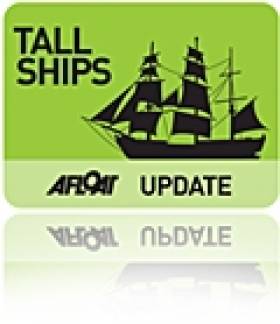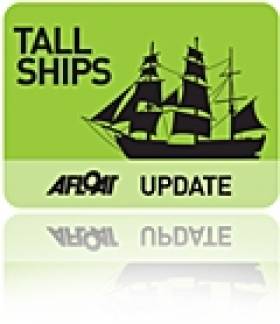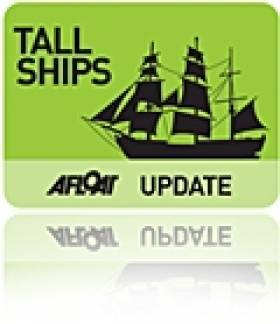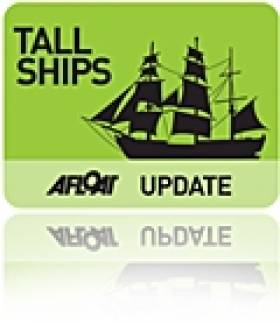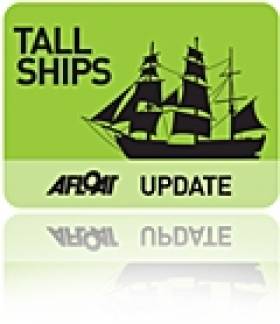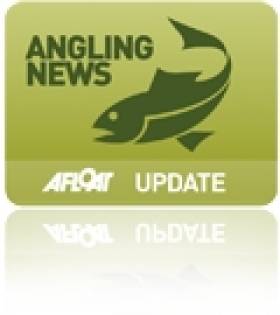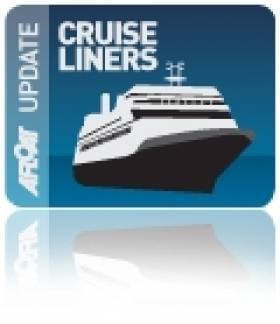Displaying items by tag: River Suir
It's Official: Third Time Tallships for Waterford
Scenes of the tallships moored alongside the north and south quays and the surrounding festivities are captured by Gary O'Mahony. SCROLL DOWN FOR PICS.
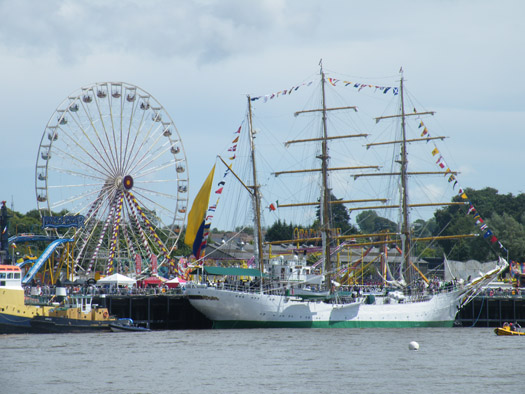
The Columbian Navy's Sailing Training Ship ARC Gloria. Photo: Jehan Ashmore
This is the second year in which the city has been the host port of the Tall Ships Race and the prestigious event is to return for a third time. The next occasion has not been confirmed but it would be several years away according to Sail Training International, the organisers of the famous race.
Lord Nelson Heads for Waterford
As the Tall Ship STS Lord Nelson nears Carnsore Point off Wexford this evening the barque will be one of the many vessels participating in the Waterford Talls Ships Races Festival, writes Jehan Ashmore.
Joining Lord Nelson are three other UK entrants, they are the Jean de la Lune, Pelican of London and Royalist now celebrating her 40th anniversary. Together these tallships belong to the 'A' class vessels, the largest of the tallships. The impressive array of A class vessels includes four ships alone from The Netherlands with the Astrid, Eendracht, Europa and Wylde Swan, a schooner built in 1920.
From Norway is the fully rigged tallship Christian Radich and Sorlandet. The Poles are coming with their Pogoria. Neighbouring Russia are sending their impressive 108m long Mir which has 26 sails and has a 200-strong crew though the 1987 built vessel can be sailed with just 30. The final A class entrant is from outside Europe, the Columbian 1,300 tonnes Gloria, a three-master of over 60 metres long.
In addition to this exciting line-up are the 'B' and 'C' class which in total brings 45 tallships of all shapes and sizes to the quays of the River Suir. The crystal city will be host to over 1,000 trainess and over 400 professional crew who will take part in the colourful 'Crew Parade' held on Friday. For a full list of tallships and accompanying photos go to www.waterfordtallshipsrace.ie/the-race/the-tall-ships/
The spectacle of the festival will culminate in the early hours of Sunday when the fleet departs the city and heads downriver with a 'Parade of Sail' in the estuary of Waterford Harbour. As the tallships pass offshore of Dunmore East, this will mark the start of the first race-leg to Greenock.
The famous race is organised by Sail Training International (STI) a charity established to harness sail training to develop and educate young people, regardless of nationality, culture, religion, gender or social background.
The STI can trace its roots with the creation of the Sail Training International Race Committee which organised the first race of sail training tall ships in 1956. Their website is www.sailtraininginternational.org/
The Return of the 'Wexford' Tall-Ship
A grant of €1m from Fáilte Ireland was allocated towards the cost of the refit as part of the National Development Plan (NDP). Visitors can now take guided tours of the floating tourist attraction though access to the shoreside visitor centre remains closed due to an upgrade. Work on an extension of a new exhibition centre is expected to be completed in May or June.
Dunbrody is a full scale reconstruction of the 19th century replica famine-ship based on the vessel built in 1845 in Quebec, Canada for the Graves family of New Ross. Ireland's most inland port being made famous with the visit of President John F. Kennedy in 1963 to the same quayside where Dunbrody is berthed.
To date the Dunbrody's presence outside her homeport has been scarce. During the Waterford Tall Ships Festival in 2005 she took part in a memorable and historic 'Parade of Sail' where she formed as part of the trio of Irish tall ships that met together for the only time. The sailing spectacle of the international fleet was headed firstly by the Irish trio with Asgard II leading followed by Dunbrody and astern the Jeanie Johnston.
In the following year Dunbrody made her maiden and only international voyage to Milford Haven in south Wales. The Pembrokeshire estuary had hosted the new festival, Seafair Haven. On that occasion she had the honour of leading another parade of sail, under the command of Captain Tom McCarthy.
Dunbrody was last dry-docked in 2006 and also at the New Ross boatyard which lies on the Co. Kilkenny side of the riverbank. The 176 foot / 54 metre barque was built in 2001 and was last vessel completed at the boatyard. During her building the public could access the yard and the construction process could be viewed from above at a gallery set within the covered building hall.
The structure no longer exists but which was built originally for the Ross Company boatyard during the 1970's. The yard specialised in building barge pontoons for markets in the North Sea until the premises closed in the 1980's. In recent years and under new management the dry-dock (75m X 15m) has been upgraded with a new gate and pump.
Looking for further reading on Tall Ships in Ireland? Click the links below:
Click this link to read all our Tall Ships Stories on one handy page
Previewing Ireland's Tall Ships 2011 Season
Can Ireland Get a New Tall Ship?
- Asgard II
- Jeanie Johnston
- river barrow
- New Ross
- River Suir
- Milford Haven
- Ports and Shipping News
- barque
- Fáilte Ireland
- Dunbrody
- Parade of Sail
- Brigantine
- Waterford Tall Ships Festival
- Dunbrody Heritage Centre
- River Nore
- New Ross Boat Yard
- Sea Haven
- National Development Plan
- NDP
- President John F. Kennedy
- Capt. Tom McCarthy
- Ross Company
- Seafair Haven
100 Days to Waterford's Tall-Ships Festival
is to draw 500,000 visitors from home and abroad. The festival is to be presented by Szczecin and organised by the Sail Training International.
Over 70 of the worlds tall-ships of all shapes and sizes will sail up the River Suir to take up residence on both sides of Waterford's city centre quays, where a major meeting of over 1,500 trainee sailors stretching from far and distant shores are to congregate.
One of the attending Class 'A' fully rigged ships, Christian Radich, which was built in 1937, incidentally provided sail-training opportunities for Irish trainees in an arrangement between her Norwegian owners and Coiste an Asgard. The sail-trainee agreement in 2009 followed the sinking of Coiste an Asgard's brigantine the Asgard II in the previous year. This was to be the last season of the state-owned sail training agency which was axed in the 2009 budget.
Another 'A' lister is the UK flagged Royalist, a brig built by Groves and Gutteridge in Cowes, Isle of Wight to a design by Colin Mudie. The 40 year old brig was named by HRH Princess Anne in 1971 for the Sea Cadet Association. She may be small for an 'A' class at just 28-metres long but the vessel can easily be spotted with her distinctive black and white painted hull.
While one of the oldest vessels to participant is the 87 year-old Brixham built trawler Provident, which along with Leader, are the only 'sailing' survivors of a once numerous traditional North Sea fishing craft. The 95-foot vessel was built at Galmpton on the River Dart. In 1991 there was a major refit of the 85 tonnes craft which has since 1999 worked from Brixham as part of the Trinity Sailing Foundation.
The event which is billed as the largest Irish festival in 2011 also presents young Irish people to experience a once in a lifetime opportunity to set sail onboard a tall-ship. The opportunity is open to those aged 16 or over by June 30 and are fit and active to be a trainee on the inaugural race leg from Waterford to Greenock (departing 3 July). For details click here.
On this date the eagerly awaited 'Parade of Sail' is set to depart the crystal city downriver on the Waterford Estuary and out into the open sea.
Looking for further reading on Tall Ships in Ireland? Click the links below:
Click this link to read all our Tall Ships Stories on one handy page
Previewing Ireland's Tall Ships 2011 Season
Can Ireland Get a New Tall Ship?
'Ferry' to Headline Waterford Tall Ships
Looking ahead to the Waterford show, Bryan Ferry said,' I am delighted to be returning to perform in Ireland following Roxy Music's performance at
Electric Picnic last year'.
Ferry will perform on the festival's main stage at Bolton Street. On the same site of the following night, The Waterboys will be supported by Waterford's O Emperor. While on the 2 July the headline act will be the Sharon Shannon Show with special guests Damien Dempsey and Dessie O'Halloran.
The four-day maritime spectacle which runs to 3 July is set to host over 70 tallships, over 1,500 trainee sailors and an anticipated 500,000 visitors that are to throng the 'Noblest Quays in Europe' with the countdown to the festival edging closer to just 100 days.
Billed as the largest Irish festival event in 2011, the return of the Tall Ships for the second time to Ireland's oldest city, presents young Irish people to experience a once in a lifetime opportunity to set sail onboard a tall-ship.
The opportunity is open to those aged 16 or over by June 30, 2011 and are fit and active to be a trainee on the inaugural race leg from Waterford to Greenock (departing 3 July). For further information click here.
The festival is not just eagerly awaited by fans of all things maritime and musical but with a programme that is also to feature street theatre, culinary and craftwork 'villages' and firework displays.
Renowned street theatre company 'Spraoi' have commissioned almost 20 national and international street performance acts. In addition the award-winning illusionist, Keith Barry will perform another specially-commissioned piece at the launch on the afternoon of 30 June.
On the nautical front, highlights include the 'Crew Parade' on 1 July and ultimately culminating with the 'Parade of Sail' by the international fleet on 3 July. Asides the city quayside on the River Suir the Waterford estuary provides excellent viewing points, some at elevated sites.
Looking for further reading on Tall Ships in Ireland? Click the links below:
Click this link to read all our Tall Ships Stories on one handy page
Previewing Ireland's Tall Ships 2011 Season
Can Ireland Get a New Tall Ship?
- street theatre
- Waterford Estuary
- River Suir
- Ports and Shipping News
- The Waterboys
- Keith Barry
- Bryan Ferry
- Roxy Music
- Waterford Tall Ships Race Festival
- TallShips
- Electic Picnic
- Sharron Shannon
- Spraoi
- Crew Parade
- Parade of Sail
- SailTrainees
- Damien Dempsey
- Dessie O'Halloran
- Noblest Quays in Europe
- RaceLeg
- WaterfordGreenock
Openings for New Salmon Season Announced
The Minister of State for Natural Resources yesterday announced more details of river openings for fishing in the New Year due to improvement in the salmon stock.
Minister Conor Lenihan announced that 52 rivers across the country - two more than 2010 - would be opened for fishing. A total of 60 will remain closed due to a lack of surplus, which is 20 fewer than last year.
Among those previously closed that will be reopened for 2011 are the Castletown, the Eske, the Glenamoy, the Kerry Blackwater and the Suir. Additional rivers will be opened on a catch-and-release basis.
The River Liffey will have a special one-time opening for fishing on New Year's Day.
Also announced was a €12 reduction in the cost of one-day angling licences, intended to encourage tourist anglers.
The Irish Times has more details on the salmon river openings and closures HERE.
Cruiseships Bound for Sunny South-East
Azamara Journey, a cruiseship built a decade ago and weighing 30,277 gross tonnes (gt) is due tomorrow (21 August) to anchor off Dunmore East. The vessel will use tender-boats to transfer passengers to the fishing port which lies on the southern approches of the Waterford estuary leading into the River Suir .
Several days after Azamara Journey's call, a further three cruise-ships will be touring the south-east. On 2 September the Crystal Symphony (51,044gt) sails overnight from Holyhead and is scheduled to take anchorage off Dunmore East and two days later a similar call is expected by the Silver Whisper. The 2001-built vessel is operated by the six-star rated Silversea Cruises.
La Diamant is due on 5 September to berth at Belview, the main port of Waterford and then is bound for the Isles of Scilly. La Diamant is owned by the only French cruise operator, Compagnie du Ponant based in Marseilles. La Diamant (8,238gt) has 172 passengers and 144 crew.
The cruise-operator specialises in offering a fleet of small bijou ships which include sail-assisted vessels. Compagnie du Ponant are a subsidiary of CMA-CGM Group, one of the world's largest container shipping companies.
Another Silversea Cruises fleetmate, Silver Cloud is due to dock on 8 September at Belview or upstream in the city-centre quays, in the heart of the newly rejuvenated 'crystal' city. Silver Cloud is on a cruise from Iceland and after the Irish call, the vessel heads for Fowey with the cruise culminating in the Pool of London.
The location of where vessels berth throughout the estuary is subject to the draft of the ship, weather conditions, tides and occupancy status of berths.


























